12聚合物基复合材料-性能
- 格式:ppt
- 大小:76.01 KB
- 文档页数:20
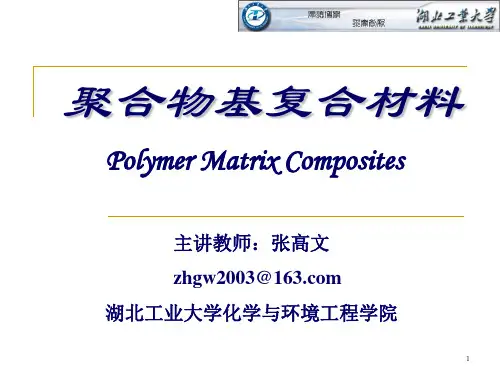

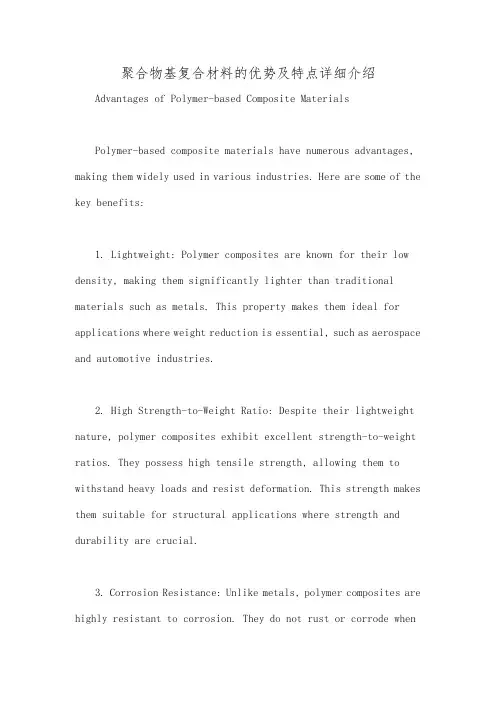
聚合物基复合材料的优势及特点详细介绍Advantages of Polymer-based Composite MaterialsPolymer-based composite materials have numerous advantages, making them widely used in various industries. Here are some of the key benefits:1. Lightweight: Polymer composites are known for their low density, making them significantly lighter than traditional materials such as metals. This property makes them ideal for applications where weight reduction is essential, such as aerospace and automotive industries.2. High Strength-to-Weight Ratio: Despite their lightweight nature, polymer composites exhibit excellent strength-to-weight ratios. They possess high tensile strength, allowing them to withstand heavy loads and resist deformation. This strength makes them suitable for structural applications where strength and durability are crucial.3. Corrosion Resistance: Unlike metals, polymer composites are highly resistant to corrosion. They do not rust or corrode whenexposed to moisture or harsh chemicals. This property makes them suitable for applications in marine environments or chemical processing industries.4. Design Flexibility: Polymer composites can be easily molded into complex shapes, offering designers immense flexibility. This versatility allows for the creation of intricate and customized components, meeting specific design requirements. It also enables the integration of multiple functionalities into a single part, reducing the need for assembly.5. Electrical Insulation: Polymer composites possess excellent electrical insulation properties. They can effectively shield against electrical currents and prevent short circuits. This characteristic makes them suitable for applications in electrical and electronic industries, where insulation is critical.6. Cost-Effectiveness: Polymer composites often offer acost-effective solution compared to traditional materials. While the initial manufacturing costs may be higher, their long-term benefits, such as reduced maintenance and longer lifespan, offset the initial investment.In conclusion, the advantages of polymer-based composite materials, including their lightweight nature, highstrength-to-weight ratio, corrosion resistance, design flexibility, electrical insulation, and cost-effectiveness, make them a preferred choice in various industries.中文回答:聚合物基复合材料的优点聚合物基复合材料具有许多优点,广泛应用于各个行业。
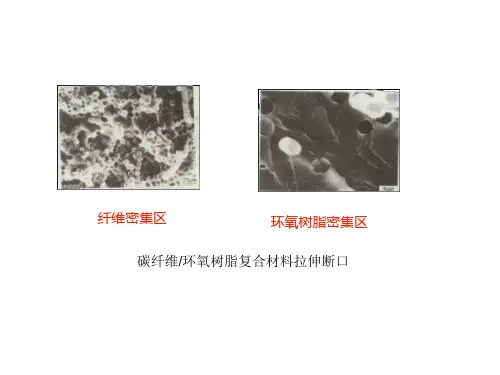
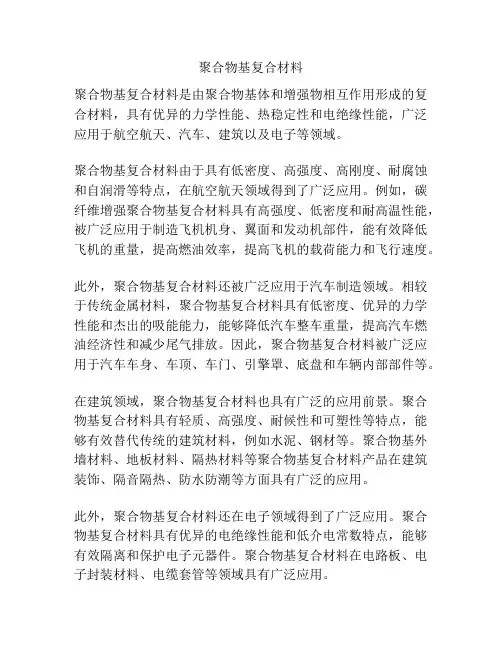
聚合物基复合材料
聚合物基复合材料是由聚合物基体和增强物相互作用形成的复合材料,具有优异的力学性能、热稳定性和电绝缘性能,广泛应用于航空航天、汽车、建筑以及电子等领域。
聚合物基复合材料由于具有低密度、高强度、高刚度、耐腐蚀和自润滑等特点,在航空航天领域得到了广泛应用。
例如,碳纤维增强聚合物基复合材料具有高强度、低密度和耐高温性能,被广泛应用于制造飞机机身、翼面和发动机部件,能有效降低飞机的重量,提高燃油效率,提高飞机的载荷能力和飞行速度。
此外,聚合物基复合材料还被广泛应用于汽车制造领域。
相较于传统金属材料,聚合物基复合材料具有低密度、优异的力学性能和杰出的吸能能力,能够降低汽车整车重量,提高汽车燃油经济性和减少尾气排放。
因此,聚合物基复合材料被广泛应用于汽车车身、车顶、车门、引擎罩、底盘和车辆内部部件等。
在建筑领域,聚合物基复合材料也具有广泛的应用前景。
聚合物基复合材料具有轻质、高强度、耐候性和可塑性等特点,能够有效替代传统的建筑材料,例如水泥、钢材等。
聚合物基外墙材料、地板材料、隔热材料等聚合物基复合材料产品在建筑装饰、隔音隔热、防水防潮等方面具有广泛的应用。
此外,聚合物基复合材料还在电子领域得到了广泛应用。
聚合物基复合材料具有优异的电绝缘性能和低介电常数特点,能够有效隔离和保护电子元器件。
聚合物基复合材料在电路板、电子封装材料、电缆套管等领域具有广泛应用。
总之,聚合物基复合材料具有轻质高强、耐高温、抗腐蚀、电绝缘等一系列优异的特性,广泛应用于航空航天、汽车、建筑和电子等领域,为各行业的发展提供了更多的可能性。
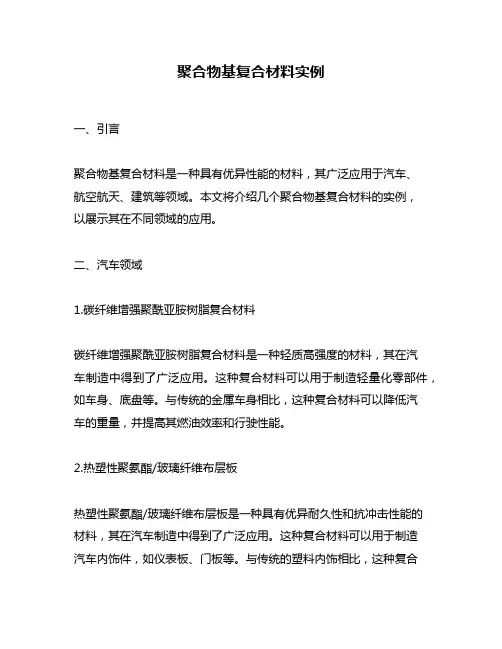
聚合物基复合材料实例一、引言聚合物基复合材料是一种具有优异性能的材料,其广泛应用于汽车、航空航天、建筑等领域。
本文将介绍几个聚合物基复合材料的实例,以展示其在不同领域的应用。
二、汽车领域1.碳纤维增强聚酰亚胺树脂复合材料碳纤维增强聚酰亚胺树脂复合材料是一种轻质高强度的材料,其在汽车制造中得到了广泛应用。
这种复合材料可以用于制造轻量化零部件,如车身、底盘等。
与传统的金属车身相比,这种复合材料可以降低汽车的重量,并提高其燃油效率和行驶性能。
2.热塑性聚氨酯/玻璃纤维布层板热塑性聚氨酯/玻璃纤维布层板是一种具有优异耐久性和抗冲击性能的材料,其在汽车制造中得到了广泛应用。
这种复合材料可以用于制造汽车内饰件,如仪表板、门板等。
与传统的塑料内饰相比,这种复合材料可以提高汽车内部的美观性和舒适性,并提高其耐用性和抗冲击性能。
三、航空航天领域1.碳纤维增强环氧树脂复合材料碳纤维增强环氧树脂复合材料是一种轻质高强度的材料,其在航空航天领域得到了广泛应用。
这种复合材料可以用于制造飞机结构件,如机翼、尾翼等。
与传统的金属结构相比,这种复合材料可以降低飞机的重量,并提高其飞行速度和燃油效率。
2.热塑性聚酰胺/玻璃纤维布层板热塑性聚酰胺/玻璃纤维布层板是一种具有优异耐久性和抗冲击性能的材料,其在航空航天领域得到了广泛应用。
这种复合材料可以用于制造飞机内部结构件,如座椅、壁板等。
与传统的塑料结构相比,这种复合材料可以提高飞机内部的美观性和舒适性,并提高其耐用性和抗冲击性能。
四、建筑领域1.玻璃纤维增强聚酯树脂复合材料玻璃纤维增强聚酯树脂复合材料是一种具有优异耐久性和抗紫外线性能的材料,其在建筑领域得到了广泛应用。
这种复合材料可以用于制造建筑外墙板、屋顶板等。
与传统的混凝土、砖墙相比,这种复合材料可以降低建筑物的重量,并提高其耐久性和抗紫外线能力。
2.聚氨酯/玻璃纤维布层板聚氨酯/玻璃纤维布层板是一种具有优异隔音性和保温性能的材料,其在建筑领域得到了广泛应用。
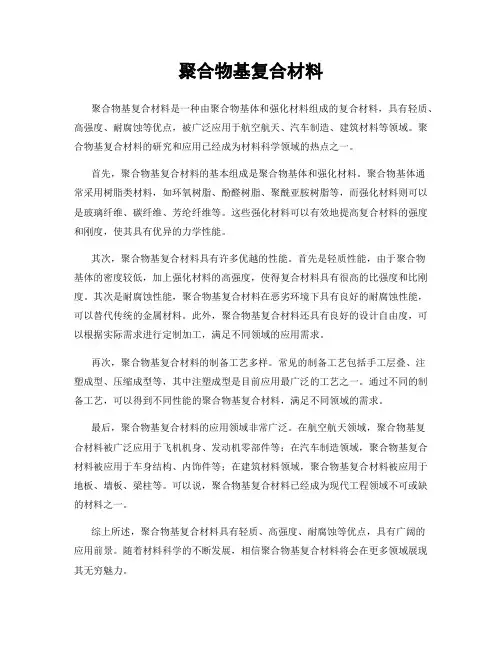
聚合物基复合材料聚合物基复合材料是一种由聚合物基体和强化材料组成的复合材料,具有轻质、高强度、耐腐蚀等优点,被广泛应用于航空航天、汽车制造、建筑材料等领域。
聚合物基复合材料的研究和应用已经成为材料科学领域的热点之一。
首先,聚合物基复合材料的基本组成是聚合物基体和强化材料。
聚合物基体通常采用树脂类材料,如环氧树脂、酚醛树脂、聚酰亚胺树脂等,而强化材料则可以是玻璃纤维、碳纤维、芳纶纤维等。
这些强化材料可以有效地提高复合材料的强度和刚度,使其具有优异的力学性能。
其次,聚合物基复合材料具有许多优越的性能。
首先是轻质性能,由于聚合物基体的密度较低,加上强化材料的高强度,使得复合材料具有很高的比强度和比刚度。
其次是耐腐蚀性能,聚合物基复合材料在恶劣环境下具有良好的耐腐蚀性能,可以替代传统的金属材料。
此外,聚合物基复合材料还具有良好的设计自由度,可以根据实际需求进行定制加工,满足不同领域的应用需求。
再次,聚合物基复合材料的制备工艺多样。
常见的制备工艺包括手工层叠、注塑成型、压缩成型等,其中注塑成型是目前应用最广泛的工艺之一。
通过不同的制备工艺,可以得到不同性能的聚合物基复合材料,满足不同领域的需求。
最后,聚合物基复合材料的应用领域非常广泛。
在航空航天领域,聚合物基复合材料被广泛应用于飞机机身、发动机零部件等;在汽车制造领域,聚合物基复合材料被应用于车身结构、内饰件等;在建筑材料领域,聚合物基复合材料被应用于地板、墙板、梁柱等。
可以说,聚合物基复合材料已经成为现代工程领域不可或缺的材料之一。
综上所述,聚合物基复合材料具有轻质、高强度、耐腐蚀等优点,具有广阔的应用前景。
随着材料科学的不断发展,相信聚合物基复合材料将会在更多领域展现其无穷魅力。
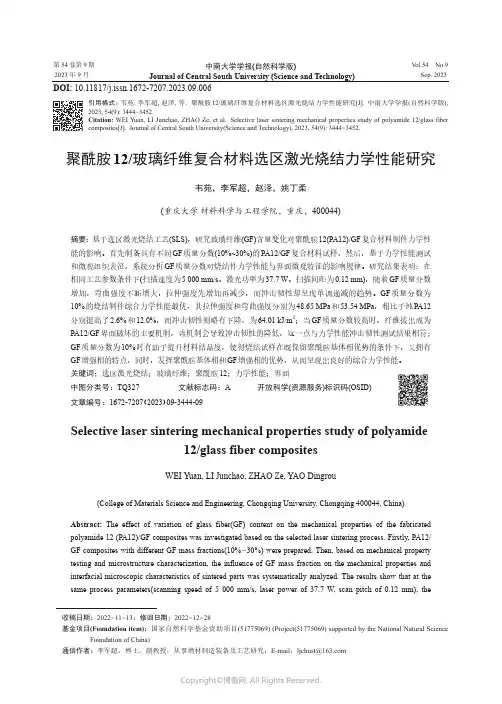
第 54 卷第 9 期2023 年 9 月中南大学学报(自然科学版)Journal of Central South University (Science and Technology)V ol.54 No.9Sep. 2023聚酰胺12/玻璃纤维复合材料选区激光烧结力学性能研究韦苑,李军超,赵泽,姚丁柔(重庆大学 材料科学与工程学院,重庆,400044)摘要:基于选区激光烧结工艺(SLS),研究玻璃纤维(GF)含量变化对聚酰胺12(PA12)/GF 复合材料制件力学性能的影响。
首先制备具有不同GF 质量分数(10%~30%)的PA12/GF 复合材料试样,然后,基于力学性能测试和微观组织表征,系统分析GF 质量分数对烧结件力学性能与界面微观特征的影响规律。
研究结果表明:在相同工艺参数条件下(扫描速度为5 000 mm/s 、激光功率为37.7 W 、扫描间距为0.12 mm),随着GF 质量分数增加,弯曲强度不断增大,拉伸强度先增加再减少,而冲击韧性却呈现单调递减的趋势。
GF 质量分数为10%的烧结制件综合力学性能最优,其拉伸强度和弯曲强度分别为48.65 MPa 和53.54 MPa ,相比于纯PA12分别提高了2.6%和12.0%,而冲击韧性则略有下降,为64.01 kJ/m 2;当GF 质量分数较高时,纤维拔出成为PA12/GF 界面破坏的主要机制,该机制会导致冲击韧性的降低,这一点与力学性能冲击韧性测试结果相符;GF 质量分数为10%时有助于提升材料结晶度,使得烧结试样在既保留聚酰胺基体相优势的条件下,又拥有GF 增强相的特点,同时,发挥聚酰胺基体相和GF 增强相的优势,从而呈现出良好的综合力学性能。
关键词:选区激光烧结;玻璃纤维;聚酰胺12;力学性能;界面中图分类号:TQ327 文献标志码:A 开放科学(资源服务)标识码(OSID)文章编号:1672-7207(2023)09-3444-09Selective laser sintering mechanical properties study of polyamide12/glass fiber compositesWEI Yuan, LI Junchao, ZHAO Ze, YAO Dingrou(College of Materials Science and Engineering, Chongqing University, Chongqing 400044, China)Abstract: The effect of variation of glass fiber(GF) content on the mechanical properties of the fabricated polyamide 12 (PA12)/GF composites was investigated based on the selected laser sintering process. Firstly, PA12/GF composites with different GF mass fractions(10%−30%) were prepared. Then, based on mechanical property testing and microstructure characterization, the influence of GF mass fraction on the mechanical properties and interfacial microscopic characteristics of sintered parts was systematically analyzed. The results show that at the same process parameters(scanning speed of 5 000 mm/s, laser power of 37.7 W, scan pitch of 0.12 mm),the收稿日期: 2022 −11 −13; 修回日期: 2022 −12 −28基金项目(Foundation item):国家自然科学基金资助项目(51775069) (Project(51775069) supported by the National Natural ScienceFoundation of China)通信作者:李军超,博士,副教授,从事增材制造装备及工艺研究;E-mail :***************DOI: 10.11817/j.issn.1672-7207.2023.09.006引用格式: 韦苑, 李军超, 赵泽, 等. 聚酰胺12/玻璃纤维复合材料选区激光烧结力学性能研究[J]. 中南大学学报(自然科学版), 2023, 54(9): 3444−3452.Citation: WEI Yuan, LI Junchao, ZHAO Ze, et al. Selective laser sintering mechanical properties study of polyamide 12/glass fiber composites[J]. Journal of Central South University(Science and Technology), 2023, 54(9): 3444−3452.第 9 期韦苑,等:聚酰胺12/玻璃纤维复合材料选区激光烧结力学性能研究bending strength increases continuously with the increase of GF mass fraction, the tensile strength increases and then decreases, while the impact toughness shows a monotonic decreasing trend. The overall mechanical properties of the sintered parts with GF mass fraction of 10% are optimal, with tensile and flexural strengths of48.65 MPa and 53.54 MPa, respectively, which are 2.6% and 12.0% higher than those of pure PA12, while theimpact toughness is slightly lower at 64.01 kJ/m2. The fiber pull-out becomes main mechanism of PA12/GF interface damage when the GF mass fraction is high, and this mechanism leads to a reduction in impact toughness, which is consistent with the mechanical properties impact toughness test results. The addition of 10% GF helps to enhance the crystallinity of the material, making the sintered specimens possess the characteristics of the GF reinforced phase while retaining the advantages of the polyamide matrix phase, and taking advantage of both the polyamide matrix phase and the GF reinforced phase, thus presenting good comprehensive mechanical properties.Key words: selective laser sintering; glass fiber; polyamide 12; mechanical properties; interface三维(3D)打印是固体自由形状的制造方法之一,它使塑造复杂的复合材料部件成为可能,这是传统的粉末成形技术无法实现的[1−3]。
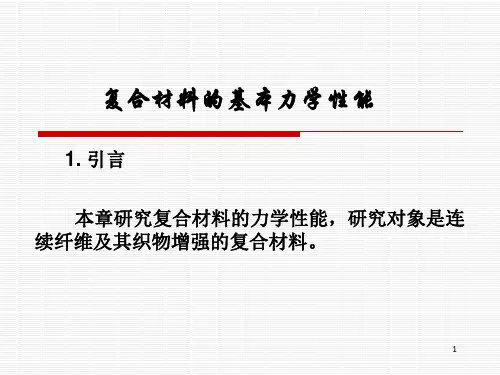

聚合物基复合材料
聚合物基复合材料是一种由聚合物基体(如聚合物树脂)和强化材料(如纤维、颗粒等)组成的复合材料。
这种复合材料结合了聚合物的可塑性和强度,以及强化材料的刚度和强度,具有优异的力学性能和工程性能。
聚合物基复合材料的制备通常包括以下几个步骤:
1. 选择合适的聚合物基体,常用的包括聚丙烯、聚酯、环氧树脂等。
2. 选择适当的强化材料,常用的有玻璃纤维、碳纤维、纳米颗粒等。
3. 基体和强化材料进行混合,可以通过热压、挤出、注塑等方法将它们混合在一起。
4. 根据需要进行后续的加工和成型,如冷却、切割、修整等。
聚合物基复合材料具有许多优点,包括:
1. 轻质高强度:与金属相比,聚合物基复合材料具有较低的密度和较高的强度,可以实现轻量化设计。
2. 耐腐蚀性:聚合物基复合材料对化学品和湿气的腐蚀性能较好,不容易受到腐蚀和氧化。
3. 良好的耐热性:聚合物基复合材料通常具有较高的耐热性和耐高温性能。
4. 良好的绝缘性能:聚合物基复合材料具有良好的绝缘性能,适用于电气和电子领域。
5. 自润滑性:聚合物基复合材料中的聚合物基体可以提供良好的自润滑性能,减少了摩擦和磨损。
由于聚合物基复合材料具有以上优点,因此广泛应用于航空航天、汽车、建筑、电子、医疗等领域,成为现代工程材料中的重要一类。
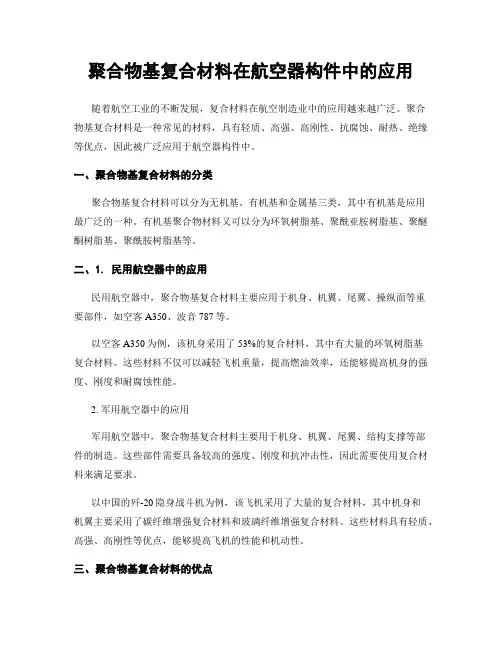
聚合物基复合材料在航空器构件中的应用随着航空工业的不断发展,复合材料在航空制造业中的应用越来越广泛。
聚合物基复合材料是一种常见的材料,具有轻质、高强、高刚性、抗腐蚀、耐热、绝缘等优点,因此被广泛应用于航空器构件中。
一、聚合物基复合材料的分类聚合物基复合材料可以分为无机基、有机基和金属基三类,其中有机基是应用最广泛的一种。
有机基聚合物材料又可以分为环氧树脂基、聚酰亚胺树脂基、聚醚酮树脂基、聚酰胺树脂基等。
二、1. 民用航空器中的应用民用航空器中,聚合物基复合材料主要应用于机身、机翼、尾翼、操纵面等重要部件,如空客A350、波音787等。
以空客A350为例,该机身采用了53%的复合材料,其中有大量的环氧树脂基复合材料。
这些材料不仅可以减轻飞机重量,提高燃油效率,还能够提高机身的强度、刚度和耐腐蚀性能。
2. 军用航空器中的应用军用航空器中,聚合物基复合材料主要用于机身、机翼、尾翼、结构支撑等部件的制造。
这些部件需要具备较高的强度、刚度和抗冲击性,因此需要使用复合材料来满足要求。
以中国的歼-20隐身战斗机为例,该飞机采用了大量的复合材料,其中机身和机翼主要采用了碳纤维增强复合材料和玻璃纤维增强复合材料。
这些材料具有轻质、高强、高刚性等优点,能够提高飞机的性能和机动性。
三、聚合物基复合材料的优点1. 轻质聚合物基复合材料的密度通常较低,可以减轻航空器自重,提高燃油效率。
2. 高强度、高刚性聚合物基复合材料的强度和刚性比传统材料高,可以更好地满足航空器对强度、刚性和耐冲击性的要求。
3. 耐腐蚀、抗氧化、耐热聚合物基复合材料可在恶劣环境下使用,具有较好的耐腐蚀、抗氧化、耐热等性能,能够提高航空器的使用寿命。
四、聚合物基复合材料的挑战1. 制造难度大聚合物基复合材料的制造过程较为复杂,需要经过多道工艺,包括树脂、纤维预浸、成型、固化等环节,需要大量的经验和技术支持。
2. 成本较高聚合物基复合材料的制造成本较高,需要先进的材料和工艺技术支持,因此目前在民航领域中的应用还存在一定的局限性。
一、1、复合材定义(ISO、GB3961)及定义包含的内容(ISO):有两种或两种以上物和化学性质同的物质组合而成的一种多和固体材。
国标GB3961 :两个或两个以上独的物相,包括粘接材(基体)和纤维或片状材所组成的一种固体物。
定义包含的内容:(1)复合材的组分材虽然保持其相对独性,但复合材的性能却是各组分材性能的简单加和,而是有着重要的改进。
(2)复合材中通常有一相为连续相,称为基体;另一相为分散相,称为增强材。
(3)分散相是以独的形态分布在整个连续相中,两相之间存在着界面。
分散相可以是增强纤维,也可以是颗状或弥散的填。
2、有机纤维碳化法将有机纤维经过稳定化处变成耐焰纤维;在惰性气氛中,于高温下进焙烧碳化,使有机纤维失去部分碳和其它非碳原子,形成以碳为主要成分的纤维状物。
3、复合材的分类按增强材形态分类:连续纤维复合材、短纤维复合材、状填复合材、编织复合材按增强纤维种类分类:玻璃纤维复合材、碳纤维复合材、玄武岩纤维复合材、有机p纤维复合材、属纤维复合材、陶瓷纤维复合材按基体材分类:环氧树脂基、酚醛树脂基、聚氨酯基、聚萨亚胺基、饱和聚芮基以及其他树脂基复合材按材作用分类:结构复合材、功能复合材4、聚合物基复合材的主要性能和目前存在的缺点:主要性能:1轻质高强(比强、比模大)2可设计性好3具有多种功能性 4过载安全性好5耐疲劳性能好6减振性好(非均相多相体系)存在的缺点:(1)材工艺的稳定性差(2)材性能的分散性大:材和产品是同时完成的,许多因素会影响到每一步的性能,质控制(3)长期耐温与耐环境化性能好(4)抗冲击性能低:大多数增强纤维伸时的断应变代小,纤维增强复合材是脆性材,抗冲击性低(5)横向强和层间剪强好等二、1、聚合物基复合材的增强材应具有的特征:(1)增强材应具有能明显提高树脂基体某种所需特性的性能,如高的比强、比模、高导热性、耐热性、低热膨胀性等,以赋予树脂基体某种所需的特性和综合性能。